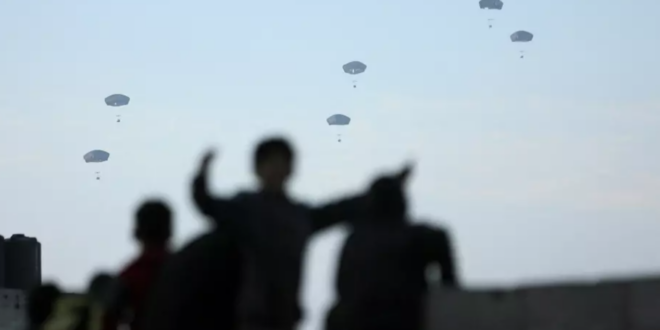Cairo .. Muhamad Yehia
On 29 February, the killing of more than 100 people waiting for food aid in Gaza City put a spotlight on the extreme deprivation and violence facing those who have remained in the north of the enclave during Israel’s nearly five-month long military campaign and siege.
Israeli authorities acknowledged that troops shot some people in the crowd that gathered on a coastal road to receive aid from a rare delivery to the north, but claimed most of the casualties were caused by a stampede or were run over by the aid trucks. Witnesses and doctors treating the wounded, however, said many of the victims appeared to have been shot. Israeli forces have reportedly opened fire on people waiting for aid multiple times in recent months.
On 26 January, the International Court of Justice ordered Israel to take “immediate and effective” steps to enable the provision of basic services and the delivery of humanitarian assistance in Gaza as part of its interim ruling in the case brought by South Africa accusing Israel of committing genocide in the enclave.
In the month following the order, the already limited amount of aid entering Gaza dropped by half, according to UN officials. Young children have begun to die of dehydration and malnutrition, and over 500,000 people are on the brink of starvation.
The situation in the north is particularly dire. Israel ordered residents to evacuate northern Gaza early in the war – a move that raised international alarm and likely violated international law. But hundreds of thousands of people are believed to have remained.
The New Humanitarian recently spoke to numerous people in northern Gaza who said people are eating grass to survive, while animal feed – which many have turned to grinding into flour for bread as a last resort – is becoming increasingly scarce.
In Beit Hanoun, in northern Gaza, Mohammad al-Madhoun said he has been unable to find milk for his daughter Sila. The two-year-old is so dehydrated she can no longer walk.
“She began vomiting blood after we forced her to eat bread made from animal feed, which we soaked in water to make it easier for her to chew,” al-Madhoun said. “Every day, I hear about new deaths due to malnutrition, and I fear that Sila will be the next.”
She weighs just six kilos – half as much as she did before the war began, he said. “Sila is my first child. I have been married for two years, and saw all my hopes in her. But today I am unable to provide milk for her,” al-Madhoun added.
The UN has been unable to deliver food aid to the north since 23 January, with Israeli authorities continuing to deny access to UN aid convoys – which their troops have fired on. In late February, the World Food Programme and the UN agency for Palestinian refugees, UNRWA, suspended aid delivery in the north, saying it had become impossible to operate safely.
The UN was not involved in the 29 February aid convoy, which was coordinated by the Israeli military and delivered by Palestinian contractors.
COGAT, the Israeli government agency responsible for coordinating with humanitarian agencies to deliver aid in Gaza, referred questions about delivery of aid in northern Gaza to the Israeli military, which did not respond to a request for comment.
Jordan, Egypt, Qatar, the UAE, the UK, France, and the United States have begun airdropping aid into Gaza. But aid agencies say this is an expensive and ineffective way to deliver assistance.
“What we need first and foremost is a ceasefire, to just put an end to this.”
Given US and UK support for Israel’s war – including the US continuing to sell weapons to Israel and vetoing ceasefire resolutions at the UN Security Council – critics have called the airdrops “performative” and “humanitarian aid theatre”. There is more Western countries can do, they say, to pressure Israel to open more border crossings with Gaza and remove the barriers preventing meaningful humanitarian operations on the ground
“What we need first and foremost is a ceasefire, to just put an end to this,” said Shaina Low, a spokesperson for the Norwegian Refugee Council. That would resolve, or at least improve, many of the barriers aid workers currently face, she said.
Low added that international law requires Israel, as the occupying power in Gaza, to provide food and medical aid to civilians: “Those responsibilities fall on Israel, and it’s the humanitarian agencies who are doing the best that they can to supplement when Israel has completely neglected or rejected its international obligations.”
Hunger and chaos
Sila’s story is not an isolated incident. In northern Gaza, one in six children under the age of two are now acutely malnourished, according to UN data. UNICEF spokesperson Laura Bill said that, while the agency has been able to do limited surveys to understand the extent of malnutrition in the north, they have repeatedly been denied access to deliver aid to treat it.

With most medical aid also blocked, people in northern Gaza are being forced to go without medications for chronic conditions, and doctors said they have run out of antibiotics and have been forced to amputate the limbs of people with traumatic injuries to prevent deaths from infection.
Mohammad’s step-brother, Sami al-Madhoun, who also lives in Beit Hanoun, said his mother has run out of insulin to manage her diabetes. She has become so malnourished and dehydrated she is now passing out several times a day.
His family has begun eating grass, and he said Israeli troops have fired at them on several occasions as they forage. “These are our choices: If we aren’t killed, we will die of hunger,” he said.
In the Jabalia refugee camp, also in the north, Rami Zaqout, 23, is sheltering about 30 displaced people in his home. This week, a three-year-old girl whose father had been killed knocked on his door late at night, asking for food.
Israeli troops withdrew from the area around the beginning of the year, but quadcopter drones sometimes fire on people in the street, and shells continue to land in the area, he said.
In one of the only signs of local government activity, a few police officers patrol occasionally – largely in civilian clothes for fear of being targeted by Israeli forces.
Because local authorities have stopped coordinating with humanitarian convoys, and because of the scarcity of food caused by the Israeli aid blockade, food drop-offs have become chaotic and dangerous, Zaqout said – something NGOs have for months been warning would happen if more aid wasn’t allowed into Gaza.
“People here almost kill each other due to the intensity of the stampede,” Zaqout said. Others have been killed by “sniping by gunmen whose identities are unknown, and some of them were killed by the Israeli army”, he added.
Also in Jabalia, Hossam Masoud, 35, described searching for leftover food in garbage containers and under destroyed and abandoned homes.
“Getting a meal of animal feed grains has become a difficult task. It forces me to walk for about four hours in the hope of finding even a kilo of it. I fall to the ground many times because my body has become thin and I am no longer able to walk,” Masoud said. He has lost about 20 kilos since the start of the war.
With no clean water available, people are drinking rainwater from a basin in the centre of the camp, which also serves as a wastewater drain. Many have become sick from the water, Masoud said.
Like many people in northern Gaza, Masoud said he had been eating animal feed, as a supplement to a single bag of flour – now almost empty – which he took from an UNRWA truck in January. He and a cousin were also able to take rice, oil, and sugar from the truck. But armed men in civilian clothes, with their faces covered, told Masoud he had more than he needed, and took everything but the flour.
Israeli authorities accuse Hamas of stealing aid. But people in northern Gaza who spoke with The New Humanitarian said they didn’t know who the masked men were.
Aid workers have suggested that some people are stealing food aid to sell on the black market at prices that are inflated due to the overall scarcity. People in Gaza told The New Humanitarian that influential families with access to weapons may be responsible and that some armed groups have emerged in the vacuum created by the Israeli military’s decimation of the Hamas-run civil and security administration, but no one knows who they answer to.
Children dying of malnutrition
At least 15 children have now died of malnutrition or dehydration, the Gaza health ministry reported on 3 March. The toll is now increasing every day.
The youngest was 45 days old, Kamal Adwan Hospital director Hossam Abu Safia told The New Humanitarian. Khaled, a severely dehydrated and malnourished two-year-old, died on 27 February after his parents fed him bread made from animal feed, Abu Safia said.
Nearly all the 300 patients admitted daily to the Al Awda Hospital in the Tal al-Zaatar area of northern Gaza are malnourished.
Another six children are in the hospital’s intensive care unit, the health ministry reported. A number of premature babies will likely die soon, Abu Safia said – the hospital has run out of infant formula and has nothing to feed them but sugar dissolved in water.
Nearly all the 300 patients admitted daily to the Al Awda Hospital in the Tal al-Zaatar area of northern Gaza are malnourished, said acting hospital director Muhammad Salha. Half of the hospital’s staff are ill, malnourished, or chronically dehydrated, he added, with some needing saline solution to rehydrate so they can continue working.
Surgeons have had to amputate the limbs of trauma patients to prevent infections because the hospital has run out of antibiotics, he added.
The hospital is also seeing more people with infectious diseases – particularly hepatitis and gastroenteritis – which are spreading quickly in unsanitary conditions and are further straining the “dilapidated” healthcare system, Salha said.
At least 90% of children in Gaza have one or more infectious diseases, including respiratory or skin infections, diarrhoea, vomiting, and fever, according to UNICEF data. In mid-February a UNICEF convoy loaded with vaccines was turned back after waiting for six hours at an Israeli military checkpoint into the north, spokesperson Laura Bill said.
Both the Kamal Adwan and Al Awda hospitals ran out of generator fuel at the end of February. Despite the desperate conditions in both facilities, it has become almost impossible to move patients to the south, explained Fikr Shalltoot, Gaza programme manager for the NGO Medical Aid for Palestinians (MAP). Ambulances are often blocked at checkpoints controlling access to and from the north, where Israeli forces have also arrested paramedics.
With the aid blockade starving the north of drugs for dialysis, oncology, and cardiac patients, and preventing their transfer to other hospitals – which are also barely functional and straining under huge patient loads – the outcome for the patients is inevitable, she said: “They will be left there in the north, and they will gradually die.”
MAP has been able to scrounge some disposable medical supplies in the north, and is gathering pumps and equipment to repair damaged hospital sewage systems. The organisation has also been able to ship some items into Gaza from Egypt, but it has been impossible to move anything beyond the south.
“The people in the north chose to stay in their homes. This is their right,” Shalltoot said. “They’re being punished because they elected to be there; they’ve done nothing except choose to stay in their homes, and now they’re being denied their very basic right to eat.”
 موقع وجه أفريقيا موقع وجه أفريقيا هو موقع مهتم بمتابعة التطورات في القارة الأفريقية
موقع وجه أفريقيا موقع وجه أفريقيا هو موقع مهتم بمتابعة التطورات في القارة الأفريقية



